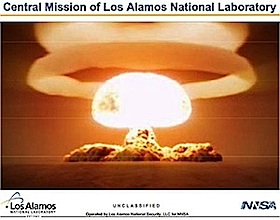“The Savannah River pit plant will cost about $11 billion to build, the NNSA said in its latest budget request: nearly two-and-a-half times as much as a preliminary estimate dating back at least to 2018. The Los Alamos pit plant will cost about $4 billion to build, the NNSA estimated in April, quoting figures from the project’s critical decision 1 review. It will cost some $30 billion to operate both plants for about 50 years, the NNSA has estimated.”
By Mary Burton Riseley | Santa Fe New Mexican
A spate of feel-good public relations articles and editorials have been published in the newspaper lately about all the beneficial work Los Alamos National Laboratory does — for example, analyzing the climate effects of wildfire smoke, helping plot the COVID-19 virus response, the economy-boosting relocation of over 500 LANL employees into otherwise unrented, empty office buildings in Santa Fe, and most recently, exploring the use of AI to predict earthquakes. With the exception of the move to Santa Fe, all of these aspects of the lab’s work are welcome.
Thanks especially to Rod Borup for the LANL work on hydrogen engines for commercial trucking.
But I, for one, cannot forget the lab’s core mission confirmed by a public presentation by its director, Thom Mason, on April 29. Always it is nuclear weapons design and development. From 100 percent of its budget in 1945, nuclear weapons work is still 79 percent. Since Rocky Flats has been closed, LANL’s mission has stretched to weapons production.

There have been better times. At the end of Jimmy Carter’s presidential term, nuclear weapons accounted for only 55 percent of LANL’s work, but Ronald Reagan quickly canceled extensive solar and geothermal energy programs. Many of us old-timers remember the vast quantities of expensive experimental solar equipment the late Ed Grothus sold from his lab outlet store, The Black Hole.
Despite the impression given by recent articles, LANL’s fiscal year 2021 budget of $3.68 billion allocates only meager amounts for nonnuclear weapons programs: 8.6 percent for nonproliferation, an estimated 6.8 percent work for others (whatever that may be), 3.1 percent for environmental cleanup, 1.7 percent for science programs, 0.1 percent for renewable energy and zero percent for energy efficiency.
Meanwhile, plutonium from past work continues to contaminate the Pajarito Plateau, as do radioactive chromium, cesium and other toxic radionuclides. This contamination is close to and upstream from Santa Fe. Why was Rocky Flats closed? Because it had so poisoned the earth and water under it that it threatened the well-being of thousands of Colorado residents.
Second, climate crisis looms, and every week brings more evidence of its acceleration through ocean warming, glacial melting with concurrent sea level rise, increased drought, wildfires and ever more violent and destructive storms. Whether we can change our lifestyle aspirations fast enough to slow these trends down is doubtful and will only happen if nations help one another.
Only by working together, the global community coming together in solidarity and collaborative aid, sharing vaccines and helping one another to reduce carbon emissions quickly and drastically, can we preserve an Earth livable for human beings.
The third existential threat is nuclear war. I hear people say, “Our country would never use these weapons; we just maintain the threat of their use to maintain world peace.” Any nuclear war anywhere would be a humanitarian and ecological disaster. If our threat is idle, it won’t work. After all, we are the only country that has ever used nuclear weapons, on Hiroshima and Nagasaki in 1945.
A threat of any kind is not what is needed to solve the other two crises. Cooperation, sharing and the opening of hearts to the needs of others is the only path to human survival. The existence and expansion of work on nuclear weapons in every nation possessing them represents to me the complete opposite of this.
The proposed vast expansion of plutonium pit manufacturing at LANL includes plans for a new design of nuclear weapon. This new design could trigger a renewed nuclear arms race, and it will either (dangerously) enter our arsenal without being tested or will end the decadeslong cessation of nuclear weapons testing.
Our country has never made a pledge to use nuclear weapons only in defense. President Barack Obama tried to move the U.S. to a “no first strike” posture in 2017, but he failed, and we still refuse to make this promise. Hopefully, President Joe Biden may change that.
I know there are many good people who work for LANL who would prefer to work on “technically sweet” projects that would actually help humanity solve our shared problems.
Please write to our senators and to Biden, urging them to convert the lab to peaceful work, and as a first step to make a pledge in our names of “no first strike” for the use of nuclear weapons.
Mary Burton Riseley is a native New Mexican who has been a peace and social justice activist for 56 years. Co-founder of the Los Alamos Study Group in 1990, she serves on the steering committee of Nuclear Watch New Mexico.
